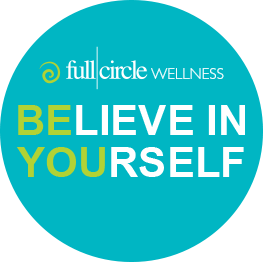Full Circle Wellness, the holistic approach to Kinesiology, Nutrition & Fitness

Salt has sparked my interest these days. First is the frequent suggestion of sea salt over table salt in healthy recipes. I’ve always wondered why, and until now, haven’t researched it. Second is the spotting of himalayan salt on the shelves. What is so special about these light pink crystals? I’ve been tempted to buy it out of curiosity, but wanted to learn why I should and what the benefits are before I do.
Table Salt, or NaCl, is the spice most of us use to add a little more flavor to our meal. It comes from underground salt mines and is highly processed and refined to remove all the minerals except for sodium (Na) and chloride (Cl). There are also anti-caking agents included to keep it from clumping. This inorganic substance now has an altered chemical structure that the body cannot easily break it down, wreaking havoc on our very sensitive system. Table salt creates an acidic environment in our bodies because it is always seeking its neutralizing counterparts – potassium, calcium, magnesium, and others. It can cause different ailments, such as arthritis, gout, and kidney and gall bladder stones. It can lead to high blood pressure and can harm the heart, kidneys, and other organs. The intake of table salt was such a problem, that many suffered from goiter. Iodine is now added to salt to prevent this and hyperthyroidism.
Sea Salt is a salt that is obtained by evaporating seawater, and is a less processed form of salt, contains more minerals, and believed to be “healthier.” It is true that there are levels of minerals, such as magnesium, potassium, calcium, and others that have remained in sea salt. The levels are so little, however, that the benefits are not incredibly effective. Additionally, according the the American Heart Association, sea salt and table salt have the same sodium content (40%) and sea salt is not actually better when it comes to watching your sodium intake.
I’ve actually never seen Himalayan Salt used at anybody’s house, but I’ve become curious as to it’s presence on the shelves. It turns out that this is the purest salt available. It comes from the abundant salt caves that were formed 250 million years ago in the Himalayas, before we created so much pollution. This salt contains 84 minerals and trace elements, nearly all of the natural elements found on the periodic table, in a raw and unprocessed form. Some of the benefits of Himalayan Salt include the following.
The American Heart Association recommends limiting sodium intake to 1,500 mg a day.
Sources:
Liebman, B. (2010). Shaving Salt, Saving Lives. (cover story). Nutrition Action Health Letter, 37(3), 1-5.
Peters, Z. (2008). GETTING SERIOUS ABOUT SALT. American Fitness, 26(2), 29.
Salt of the earth. (2010). Prevention India, 7.
Lyons, C. (2007). UNEARTHING salt. Ebony, 62(12), 186-192.
Crystal Balance Himalayan Rock Salt
Why Himalayan Pink Crystal Salt is so much better for your health than processed table salt
8 Surprising Benefits of Pink Himalayan Salt
What’s the difference between Sea Salt and Table Salt?
10 Amazing Benefits of Pink Himalayan Salt
 benefits
benefits
 health
health
 Himalayan Salt
Himalayan Salt
 Sea Salt
Sea Salt
 Table Salt
Table Salt
 Nutrition & Diet Tips
Nutrition & Diet Tips
 Full Circle Wellness Services
Full Circle Wellness Services
 Nutrition & Diet Tips
Nutrition & Diet Tips
 Wellness Articles & Resources
Wellness Articles & Resources
 Wellness Q&A
Wellness Q&A
 Winter Motivation
Winter Motivation
 Charity
Charity
 Corporate Wellness
Corporate Wellness
 Exercise & Fitness Tips
Exercise & Fitness Tips
 Inspiration & Motivation
Inspiration & Motivation
 Kinesiology
Kinesiology
 Motivation
Motivation
 Nutrition & Diet Tips
Nutrition & Diet Tips
 Races & Events
Races & Events
 Wellness Articles & Resources
Wellness Articles & Resources

Through non invasive & proven methods, Full Circle Wellness will help you balance the 3 elements of wellness - Mental, Chemical & Structural. Optimal health begins with balance!
 Start your full circle journey TO BALANCE
Start your full circle journey TO BALANCE
© 2023 Copyright Full Circle Wellness.Company web design by Web Solutions Desk